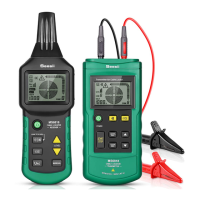Operating instructions for Cable Detector, article 37270766
Page 19 of 34
5.1.6
Locating
blockages
in non-
conductive
lines
Requirements:
The pipeline must be of non-conductive material (such as plastic).
The pipeline must not be electrically charged.
The transmitter must be connected to a metallic pipe coil (metallic pipe or flexible protective pipe) and an
auxiliary ground as shown in Fig. 3-1-6.
Use the measurement procedure as shown in the example.
1. If the pipeline is carrying electrical current, the current must be switched off and the pipeline must be
grounded.
2. Connect the grounding wire in accordance with applicable regulations. The transmitter should have enough
distance to the pipeline being measured. If the distance is too small, the signal and the modelled circuit
cannot be precisely located.
1. During tracking, at the break location there will be an
abrupt decline in the signal shown at the receiver.
2. Adjust the transmitter power to suit the different
search radii.
3. The position you are searching for can be detected
precisely by switching the receiver to manual mode
and setting the right sensitivity.
4. A second transmitter is not absolutely necessary for
this application. For using just one transmitter, see
Fig. 3-5-1a.
1. If you find only a pipeline made of non-conductive
material (like glass fibre), we recommend inserting a
metal wire with about 1.5 mm² cross-section into the
non-conductive pipe and to the narrow or blocked
section.
2. The stronger the signal shown on the receiver, the
closer the receiver is to the pipeline under test.
3. When the signals to the receiver suddenly get
weaker during testing along the pipeline, the
problem area has been found.
4. Adjust the transmitter power to suit the different
search radii. Set the receiver to manual mode and set
the right sensitivity to precisely locate the problem
area.

